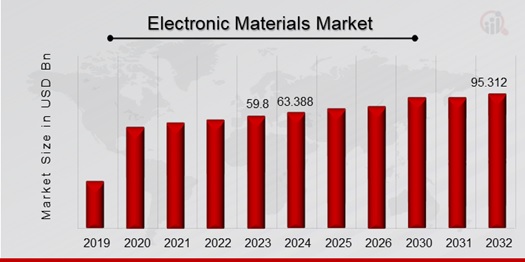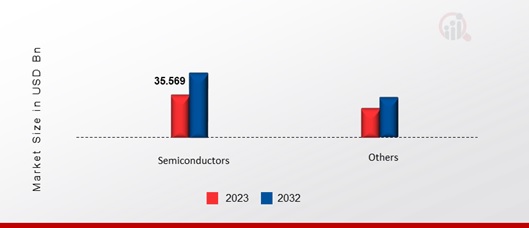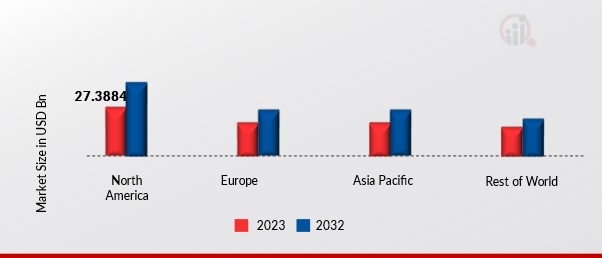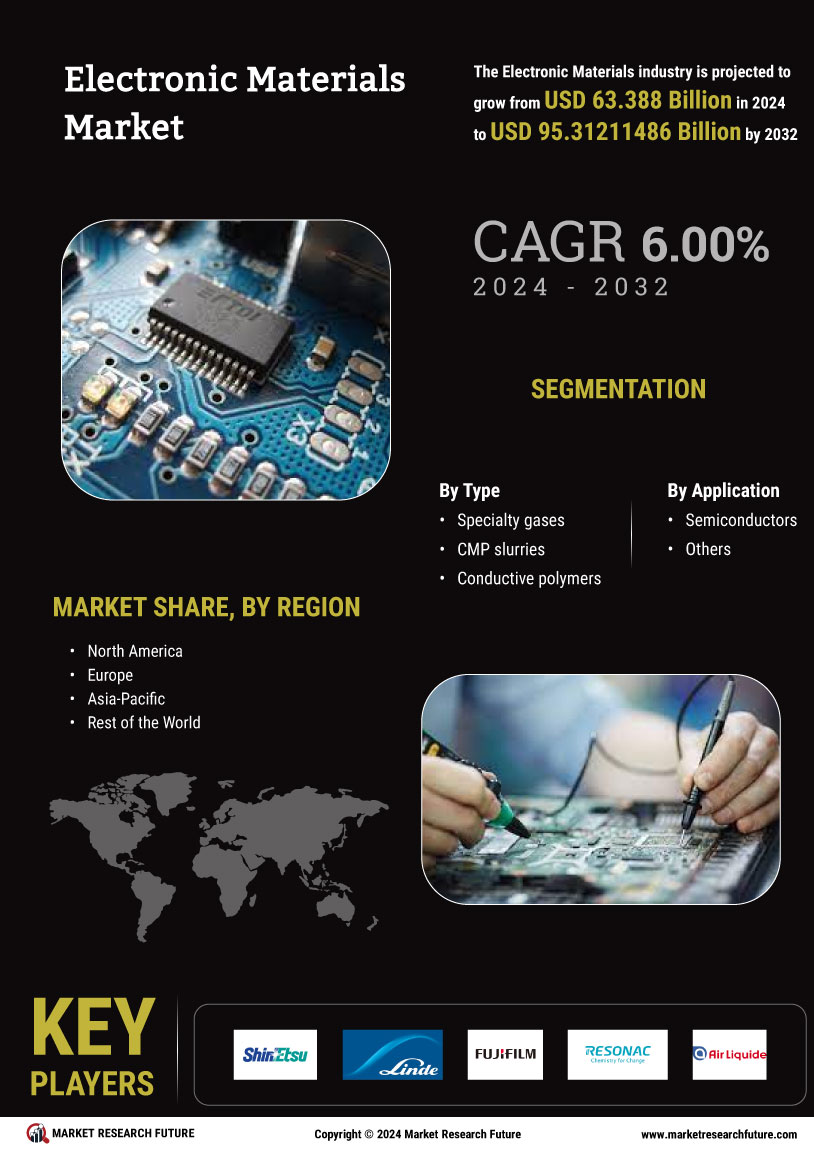Global Electronic Materials Market Overview
Electronic Materials Market Size was valued at USD 59.8 Billion in 2023. The Electronic Materials industry is projected to grow from USD 63.388 Billion in 2024 to USD 95.31211486 Billion by 2032, exhibiting a compound annual growth rate (CAGR) of 6.00% during the forecast period (2024 - 2032). Emerging technologies such as 5G, artificial intelligence (AI), Internet of Things (IoT), augmented reality (AR), and virtual reality (VR) rely on electronic components that require specialized materials and are the key market drivers enhancing the market growth.

Source: Secondary Research, Primary Research, MRFR Database and Analyst Review
Electronic Materials Market Trends
- Consumer electronics demand is driving the market growth
The consumer electronics demand is driving market CAGR for electronic materials. This surge is propelled by various factors, including the continuous advancements in electronic devices such as smartphones, laptops, and wearables, alongside the expanding penetration of IoT devices and smart home technologies. As consumers seek more sophisticated and feature-rich electronic products, manufacturers are under pressure to innovate and optimize their manufacturing processes, driving the demand for high-performance electronic materials. Additionally, the proliferation of emerging technologies like 5G, artificial intelligence, and augmented reality further amplifies the need for advanced electronic materials capable of meeting the stringent performance requirements of these applications.
Additionally, emerging technologies such as 5G, artificial intelligence (AI), Internet of Things (IoT), augmented reality (AR), and virtual reality (VR) rely on electronic components that require specialized materials, driving growth in the electronic materials market. These cutting-edge technologies rely on advanced semiconductor materials, high-performance substrates, and precision-engineered coatings to enable their functionalities. For instance, 5G networks require highly efficient RF filters and antennas, while AI systems demand advanced processors and memory chips. IoT devices rely on sensors, microcontrollers, and energy-efficient batteries, while AR and VR applications require high-resolution displays and immersive audio systems. As these emerging technologies continue to evolve and increase across industries such as telecommunications, automotive, healthcare, and entertainment, the electronic materials market is poised for substantial growth. Material suppliers and manufacturers are innovating to meet the stringent performance, reliability, and scalability requirements of these technologies, driving investments in research and development and spurring the development of next-generation electronic materials tailored to the unique needs of each application.
The growing adoption of electric vehicles and renewable energy technologies increases the demand for electronic materials used in batteries, power electronics, and photovoltaic cells, driving market growth. As the world transitions towards cleaner and more sustainable energy sources, there is an unprecedented demand for electronic materials essential for the production of advanced batteries, power electronics, and photovoltaic cells. This surge in demand is driven by the need for high-performance materials capable of enhancing the energy storage capacity, efficiency, and lifespan of EV batteries while also enabling the efficient conversion and management of renewable energy in power electronics systems. Consequently, electronic materials suppliers are innovating and expanding their product offerings to cater to the specific requirements of the EV and renewable energy sectors, thereby driving significant market growth. This trend is expected to accelerate further as governments, businesses, and consumers worldwide increasingly prioritize decarbonization and energy transition initiatives, underscoring the pivotal role of electronic materials in facilitating a sustainable future. Thus driving the Electronic Materials Market revenue.
Electronic Materials Market Segment Insights:
Electronic Materials Type Insights
The Electronic Materials Market segmentation, based on type, includes specialty gases, CMP slurries, conductive polymers, photoresist chemicals, low-k dielectrics, wet chemicals, silicon wafers, and PCB laminates. In 2023, the specialty gases segment dominated the market, accounting for 35% of market revenue due to their critical role in semiconductor manufacturing processes such as chemical vapor deposition (CVD) and etching.
Electronic Materials Application Insights
The Electronic Materials Market segmentation, based on Application, includes semiconductors and others. In 2023, the semiconductors category generated the most income because there is a growing need for electronic components in many different industries, such as telecommunications, automotive, industrial automation, and consumer electronics.
Figure 1: Electronic Materials Market, by Application, 2023 & 2032 (USD Billion)

Source: Secondary Research, Primary Research, MRFR Database and Analyst Review
Electronic Materials Regional Insights
By region, the study provides market insights into North America, Europe, Asia-Pacific, and the Rest of the World. The North American Electronic Materials Market area will dominate this market, owing to its robust semiconductor industry, technological innovation, and strong presence of key players such as Dow Electronic Materials, DuPont, and Lam Research. Additionally, the region's focus on research and development, coupled with a favorable regulatory environment, fuels the adoption of advanced electronic materials, driving market growth.
Further, the major countries studied in the market report are the US, Canada, Germany, France, the UK, Italy, Spain, China, Japan, India, Australia, and South Korea.
Figure 2: ELECTRONIC MATERIALS MARKET SHARE BY REGION 2023 (USD Billion)

Source: Secondary Research, Primary Research, MRFR Database and Analyst Review
Europe's Electronic Materials Market accounts for the second-largest market share due to its strong presence in semiconductor manufacturing, innovative materials research, and a robust electronics ecosystem. Further, the German Electronic Materials Market held the largest market share, and the UK Electronic Materials Market was the fastest-growing market in the European region.
The Asia-Pacific Electronic Materials Market is expected to grow at the fastest CAGR from 2024 to 2032. This is due to increasing demand for electronic devices, coupled with government initiatives to support the semiconductor industry. Moreover, China’s Electronic Materials Market held the largest market share, and the Indian Electronic Materials Market was the fastest-growing market in the Asia-Pacific region.
Electronic Materials Key Market Players & Competitive Insights
Leading market players are investing heavily in research and development in order to expand their product lines, which will help the Electronic Materials Market grow even more. Market participants are also undertaking a variety of strategic activities to expand their global footprint, with important market developments including new product launches, contractual agreements, mergers and acquisitions, higher investments, and collaboration with other organizations. To expand and survive in a more competitive and rising market climate, the Electronic Materials industry must offer cost-effective items.
Manufacturing locally to minimize operational costs is one of the key business tactics used by manufacturers in the global Electronic Materials industry to benefit clients and increase the market sector. In recent years, the Electronic Materials industry has offered some of the most significant advantages to industries. Major players in the Electronic Materials Market, including Shin-Etsu Chemical Co., Ltd. (Japan), Linde Plc (England), Fujifilm Corporation (England), Resonac Holding Corporation (Japan), Air Liquide (Paris), Solvay (Belgium), BASF SE (Germany), MITSUI CHEMICALS AMERICA, INC. (US), Merck KGaA (Germany), Covestro AG (Germany).
Dow Electronic Materials is a leading provider of materials and technologies for the semiconductor, display, and electronic packaging industries. The company focuses on innovation and collaborates closely with semiconductor manufacturers to develop advanced materials for next-generation devices. Dow Electronic Materials has a global presence and a strong R&D capability, allowing it to stay competitive in rapidly evolving markets.
Shin-Etsu Chemical is a major supplier of silicones, semiconductor silicon wafers, and other electronic materials. The company has a strong presence in the semiconductor industry and provides high-quality materials essential for semiconductor manufacturing processes. Shin-Etsu Chemical focuses on quality, reliability, and technological innovation to maintain its competitive position in the market.
Key Companies in the Electronic Materials Market include
- Shin-Etsu Chemical Co., Ltd. (Japan)
- Linde Plc (England)
- Fujifilm Corporation (England)
- Resonac Holding Corporation (Japan)
- Air Liquide (Paris)
- Solvay (Belgium)
- BASF SE (Germany)
- MITSUI CHEMICALS AMERICA, INC. (US)
- Merck KGaA (Germany)
- Covestro AG (Germany)
Electronic Materials Industry Developments
March 2023: Shin-Etsu Chemical expanded its production capacity for semiconductor silicon wafers to meet the growing demand from the global semiconductor industry. The company is also focusing on developing high-purity materials and advanced packaging solutions to support the development of next-generation electronic devices, including 5G smartphones and IoT devices.
January 2024: Sumitomo Chemical announced partnerships and collaborations with leading semiconductor manufacturers to develop advanced materials for semiconductor manufacturing processes, including materials for advanced lithography, deposition, and etching. The company also invested in research and development to address emerging trends in the semiconductor industry, such as the adoption of artificial intelligence and machine learning in semiconductor fabrication.
February 2021: Samsung SDI announced significant investments in the expansion of its battery manufacturing facilities, aiming to meet the increasing demand for electric vehicle batteries and energy storage systems. The company also focused on developing next-generation battery technologies, including solid-state batteries, to enhance performance and safety.
Electronic Materials Market Segmentation
Electronic Materials Type Outlook
- Specialty gases
- CMP slurries
- Conductive polymers
- Photoresist chemicals
- Low k dielectrics
- Wet chemicals
- Silicon wafers
- PCB laminates
Electronic Materials Application Outlook
Electronic Materials Regional Outlook
- North America
- Europe
- Germany
- France
- UK
- Italy
- Spain
- Rest of Europe
- Asia-Pacific
- China
- Japan
- India
- South Korea
- Australia
- Rest of Asia-Pacific
- Rest of the World
- Middle East
- Africa
- Latin America
| Report Attribute/Metric |
Details |
| Market Size 2023 |
USD 59.8 Billion |
| Market Size 2024 |
USD 63.388 Billion |
| Market Size 2032 |
USD 95.31211486 Billion |
| Compound Annual Growth Rate (CAGR) |
6.00% (2024-2032) |
| Base Year |
2023 |
| Market Forecast Period |
2024-2032 |
| Historical Data |
2019- 2022 |
| Market Forecast Units |
Value (USD Billion) |
| Report Coverage |
Revenue Forecast, Market Competitive Landscape, Growth Factors, and Trends |
| Segments Covered |
Type, Application, and Region |
| Geographies Covered |
North America, Europe, Asia Pacific, and the Rest of the World |
| Countries Covered |
The US, Canada, Germany, France, UK, Italy, Spain, China, Japan, India, Australia, South Korea |
| Key Companies Profiled |
Shin-Etsu Chemical Co., Ltd. (Japan), Linde Plc (England), Fujifilm Corporation (England), Resonac Holding Corporation (Japan), Air Liquide (Paris), Solvay (Belgium), BASF SE (Germany), MITSUI CHEMICALS AMERICA, INC. (US), Merck KGaA (Germany), Covestro AG (Germany) |
| Key Market Opportunities |
· The rising popularity of flexible and printed electronics for applications such as flexible displays, RFID tags, and wearable sensors creates opportunities for materials that can withstand bending, stretching, and conformal integration onto various substrates. |
| Key Market Dynamics |
· The increasing demand for consumer electronics, including smartphones, tablets, laptops, and wearable devices, fuels the need for electronic materials that enable the production of compact, lightweight, and high-performance devices. |
Frequently Asked Questions (FAQ) :
The Electronic Materials Market size was valued at USD 59.8 Billion in 2023.
The global market is projected to grow at a CAGR of 6.00% during the forecast period, 2024-2032.
North America had the largest share of the global market.
The key players in the market are Shin-Etsu Chemical Co., Ltd. (Japan), Linde Plc (England), Fujifilm Corporation (England), Resonac Holding Corporation (Japan), Air Liquide (Paris), Solvay (Belgium), BASF SE (Germany), MITSUI CHEMICALS AMERICA, INC. (US), Merck KGaA (Germany), Covestro AG (Germany), and others.
The specialty gases category dominated the market in 2023.
The semiconductors had the largest share in the global market.

















